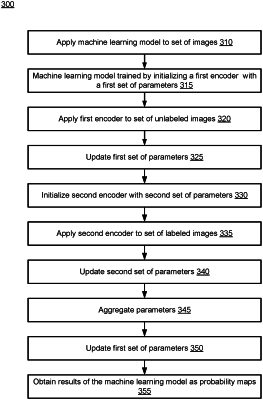| CPC G06T 7/0012 (2013.01) [G06N 3/045 (2023.01); G06N 3/08 (2013.01); G06T 7/11 (2017.01); G06T 2207/20076 (2013.01); G06T 2207/20081 (2013.01); G06T 2207/20084 (2013.01); G06T 2207/30048 (2013.01)] | 20 Claims |

|
1. A computer implemented method of segmenting a set of images comprising:
applying a machine learning model to the set of images to generate results, wherein the machine learning model was trained by:
initializing a first encoder with a first set of parameters,
applying the first encoder to a set of unlabeled images to generate a set of representations of the unlabeled images,
updating the first set of parameters based on the set of representations, initializing a second encoder with a second set of parameters,
applying the second encoder to a set of labeled images to generate a set of predictions of a location of a feature within each image in the set of labeled images, wherein each respective label is associated with the location of the feature in the respective labeled image,
updating the second set of parameters based on the set of predictions, aggregating the updated first set of parameters and the updated second set of parameters into a set of aggregated parameters, and
updating the first set of parameters based on the set of aggregated parameters; and
obtaining the results of the machine learning model as a probability map for each image in the set of images.
|